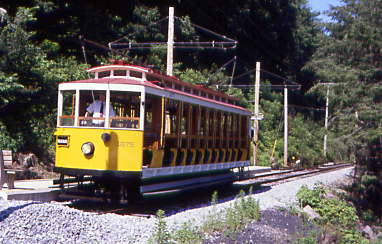
Chris Parker and I finished photographing the buildings of the East Broad Top Railroad when I saw the first trolley being brought out for the day's activities at the Rockhill Trolley Museum. We walked over and caught it coming out to their station. This is Pennsylvania's oldest operating trolley museum.
Rockhill Trolley MuseumThe Rockhill Trolley Museum is a museum and heritage railway in Rockhill Furnace, Pennsylvania that collects and restores trolley, interurban and transit cars. Founded in 1960, the museum operates what has been historically referred to as the Shade Gap Electric Railway to demonstrate the operable pieces in its collection. "Shade Gap" refers to the name of a branch of the East Broad Top Railroad, from whom the museum leases it property.
The first car acquired by the museum in 1960 was Johnstown Traction 311. Recent acquisitions include Public Service Coordinated Transport (later New Jersey Transit), Newark, NJ Presidents' Conference Committee Car 6 and Iowa Terminal Railroad Snow Sweeper 3.
The museum formerly operated under its corporate name, Railways to Yesterday. It changed to its current name to acknowledge and enhance its relationship with, and provide mutual promotional support to, its hometown.
The museum is open from May through October and for special holiday events. For the latter, including Easter, Pumpkin Festival in October and Christmas in Coal Country, the museum partners with the East Broad Top Railroad, which is across the street. While the two organizations are not formally affiliated and do not cross-honor tickets, the railroad sells tickets for the combined events with the trolley museum and the two organizations share volunteers and labour expertise.
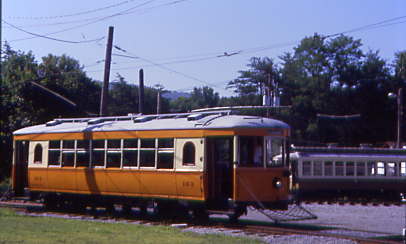
York Railways Company rare curved-side 163 built by Brill in 1924. The most ambitious restoration project our museum has undertaken to date is York Railways 163. Another trolley builder, the Cincinnati Car Company, had a patent on the curved-side car. Brill built five curved-side cars for York Railways and in doing so, infringed on the patent. Cincinnati sued Brill. Consequently, these five curved-side cars were the only ones built by Brill. York 163 is the only preserved and operable trolley from theYork Railways system, which stopped all streetcar operations on February 4, 1939. Car 163 was sold to be used as a summer home along Conewago creek north of York and body survived there until 1972, when Hurricane Agnes completely flooded the car, knocking it off its foundation. The owners no longer wanted the car and donated the body to the museum.
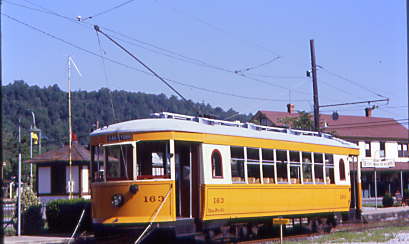
York Railways 163 at the station platform with the Orbisonia station behind. I met the operator, who was expecting us, and took us to Car Barn 1.
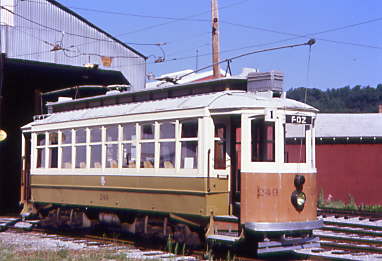
In front was S.T.C.P. Sociedade de Transportes Colectivos do Porto 'Maxi-traction' semi-convertible 249 built by Brill in 1904. The windows on this car can be raised into the roof of the car to create an airy 'open car' effect and coudl also be lowered quickly in the event of a rainstorm or cool weather. This Brill-built, designed and patented car is typical of thousands of similar small cars that operated around small town and through the streets of United States cities. Semi-convertible cars like 249 replaced convertible and open cars on many systems, because they could operate year-round. In 1924, car 249 was re-motorized with two motors and continued serving citizens of Porto until 1972, when it was retired. It was acquired by Rockhill Trolley Museum in October of that year. After being shipped across the Atlantic Ocean in a large wooden box, 249 was unloaded in Philadelphia and trucked to the museum. Unlike many other cars that have arrived at the museum needing years of costly restoration work, 249 arrived in good condition and entered regular service immediately.
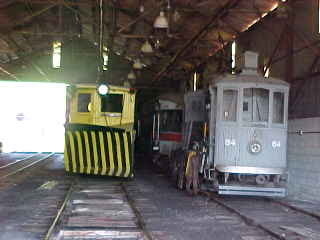
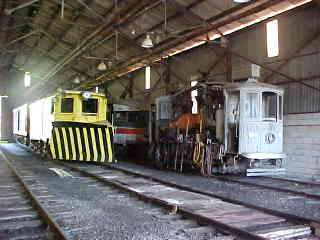
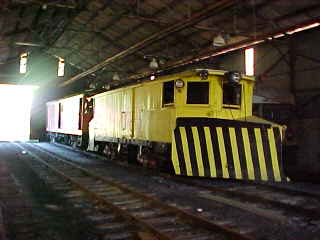
On the left is Philadelphia & Western snowplough 10 built by Wason in 1915 and used to clear heavy snows from tracks of the Philadelphia & Western Railroad. Known as a shear plough, car 10 pushed snow to the right side of the track only. Some ploughs were also built which pushed snow to both sides of the track. The ploughs of car 10 can be raised manually or pneumatically. It served its entire career operating on fourteen miles of track between Norristown and 69th Street Terminal in Upper Darby. It is believed the car may have occasionally been used to clear snow from the city streets of Norristown and the tracks of the Lehigh Valley Transit system as far north as Lansdale. Trolley plough 10 was in use until 1988 when it was acquired by our museum from SEPTA and was the last operating trolley snowplough on any American transit system. Since its arrival at the museum, it has had some woodwork done to the body, the entire car has been repainted and relettered, and it has received mechanical maintenance. It is one of few trolley snowploughs in existence today.
On the right is S.T.C.P. Sociedade de Transportes Colectivos do Porto single-truck freight flat C-64 built by the railroad in 1933. One of the most useful trolleys at our museum is our track service car from Porto, Portugal. According to the Porto trolley museum, some of these cars hauled coal straight from mines to the company's electric power plant. Others were used to remove ash from the power plant and some to haul odd freight – including fish – between the port and the markets. The sides of the four-wheeled car fold down, allowing easy access to the load. Car 64 was acquired by our museum in 1967 along with Porto car 172. Both cars were brought across the Atlantic Ocean aboard a ship to Philadelphia. Two trucks were then used to transport the antique trolley cars to our Museum. Since its arrival at our Museum, car 64 has been outfitted with an electric arc welder, acetylene cutting torch, air compressor, generator and numerous hand and power tools.
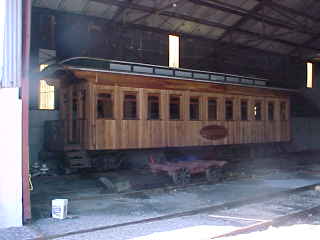
Harrisburg Railways wooden semi-convertible 710 built by Brill in 1913. This is an unusual car since it was constructed with an arch roof and a semi-convertible window pattern. The windows of this car slide up into the roof of the car, as they do in Porto Cars 172 and 249, both operating at the museum. Car 710 was in operation until the end of trolley service in Harrisburg on July 15, 1939. It was quite common for old trolley bodies to be sold and used as summer homes, sheds or club houses. For 47 years, 710 was used as a summer home near Mt. Holly Springs, Pennsylvania. After many years in Mt. Holly Springs, the car's owner passed away and the family no longer wanted the car. A building had been built around the entire car to provide additional living space during its years as a summer home. Our volunteers cleared the building away from car 710 and moved it to our site.
Car 710 is a very historic car, being one of only two cars from Harrisburg preserved today. While car 710 will take years of restoration work to return it to operation, parts are being gathered now to insure that one day car it will return to the rails.There was a trolley under restoration minus its trucks.

Philadelphia & Western freight motor 402 built by Detroit United Railways in 1920. The exact origins of very unique Philadelphia and Western Freight Motor 402 remain somewhat unclear. It can be reasonably assumed that the car was constructed around 1920 in the Highland Park shops of the Detroit United Railway and numbered 2010. The DUR both built and reconstructed a number of cars in house during the 1920s that have similar construction details to the 2010.
In 1943, the Philadelphia & Western lost its wooden freight motor 402 due to fire and needed a replacement due to wartime demands. The P&W acquired the 2010 from Frank Judge as part of an insurance settlement from the destruction of the original 402. Thus, 2010 was loaded on a flatcar and was delivered to the P&W via its interchange connection with the Pennsylvania Railroad's Cardington Branch at 69th Street in Upper Darby. Upon receipt by the P&W, the car was converted to a double-ended third-rail only motor and a door was cut into the former rear end of the car. The door enabled the car to carry long loads, like sticks of rail.
The 402 was used to haul freight as part of the P&W's meager interchange freight operation, which dwindled down to only a few carloads per year by the 1950's. The car was extensively used in work service and for towing of disabled equipment. The 402 towed both former Chicago, North Shore and Milwaukee Electroliners from the Pennsylvania Railroad interchange in 1963 and would later rescue these trains when they broke down on the line as well. The car also frequently towed the "pickle car", which was a flatcar equipped to spray de-icing chemicals on the third rail in freezing weather. The car would later be modified with a small plow under each platform to clear snow away from the third rail. The car passed into ownership of the PST Company in 1954 and SEPTA in 1970.
The car continued in use by SEPTA until 1990, when it was retired and offered for museum preservation. Railways To Yesterday, Inc., operators of the Rockhill Trolley Museum, acquired the car the same year and transported it to the museum site in Rockhill Furnace where it entered service in 1991. The car needed extensive control system work after acquisition by the museum as it had been used by SEPTA for load testing of new substations which caused significant damage.
Once finished in Car Barn 1, we walked down the dual gauge track to Car Barn 2 and after unlocking the door and turning on the power to the building, we started our tour.
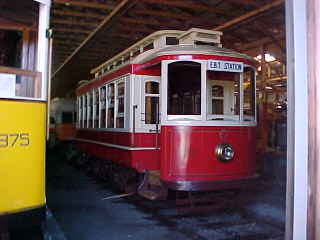
Sociedade de Transportes Colectivos do Porto single-truck semi-convertible 172 built by S.T.C.P in 1929. Car 172 is a Brill semi-convertible design, meaning the windows can be raised into roof pockets. This creates an open summer car effect with the convenience of being able to lower the windows in case of a rain storm or cool weather.
Car 172 is our example of a Toonerville trolley, a small two-axle trolley. The nickname comes from a series of silent comedy films by that name, which featured a rickety little trolley bouncing along the countryside as its motorman engaged in a series of comical adventures. Car 172 which is coincidentally where the first Toonerville trolley movies were made, before Hollywood even existed. Car 172 was built in Porto, Portugal in 1929, although it looks very similar to cars that operated in the United States around 1900. Porto built a large fleet of these cars in their shops. Car 172 has an attractive interior, the very ornate carved wood trim, fancy brass fittings and sliding end doors. It also has a unique seating arrangement, with two seats on one side and one seat on the other, made necessary by the narrow twisting streets of Porto. Car 172 came across the Atlantic Ocean with Porto work car 64 in 1967.
Both cars were trucked aboard highway trailers from Philadelphia to our museum. While several other American museums and groups have acquired cars from Porto, our Museum was the first to import cars from that city. Car 172 was in operating condition upon arrival at the museum and was placed in passenger operations immediately. Its four wheels give a bouncy ride, as frequently parodied in the Toonerville Trolley films. The body of 172 has been restored in our Buehler Shop and is a favourite with our visitors. Like sister car 249 from hilly Porto, 172 has three separate braking systems: air brakes, hand brakes, and dynamic brakes.
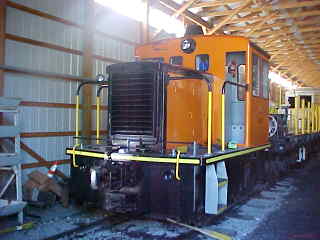
Daimler Chrysler (Adtranz) Rockhill 25 ton switcher M-25 built by General Electric Company in 1942 for use at a Hudson Motor Car plant at Centerline, Michigan. Information received from a Hudson authority in 2006 indicates this plant built 20 mm Oerlikon anti-aircraft guns for the Navy. (The Hudson Motor Car plant has sometimes mistakenly been thought to have built torpedo boats). Centerline reportedly had space for 20 rail cars on a 900 foot loading dock, so the loco was probably kept quite busy at its first home. Hudson lost the contract to operate that plant in October 1943; sometime around that date the locomotive was moved to the Naval Mine Depot at Yorktown, Virginia. Following World War II, it was sold to Tidewater Oil Company in Delaware City, Delaware. By 1972, it had been sold to the American Bridge Division of US Steel at Elmira, New York. While with AmBridge, the locomotive reportedly served during construction of the Interstate 81 bridge over the Susquehanna River at Harrisburg, Pennsylvania. It was used to shuffle loads of steel out onto the bridge for placement by a travelling crane.
The locomotive was at the AmBridge plant in Elmira when it changed hands to Sumitomo Corporation, ABB Traction, Adtranz and finally DaimlerChrysler. All these companies performed construction and overhaul of trolley, subway and light rail equipment.
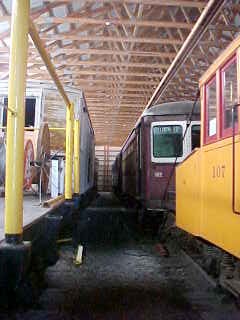
Philadelphia & Western 162 interurban car built by J.G. Brill Company in 1927. As originally constructed, the car had ground level steps, end doors and trolley poles, as well as parcel racks inside the car and a separate smoking compartment. The car was designed for operation by both a motorman and a conductor and had a top or "balancing" speed of 44 miles per hour as constructed. Car 62 and the other 10 cars of this class became virtually obsolete with the arrival of the high-speed "Bullet" cars in 1931. Thus, the entire class of cars was rebuilt between 1931 and 1935 which included a lowering of the car's center of gravity via new floors and smaller wheels, removal of the end doors, steps, trolley poles and side entrance doors. The maximum speed of the car was also increased to 68 miles per hour in order to maintain the new, faster schedules.
Car 162 and the other cars of its class spent most of their lives after their rebuilding in use on the Strafford Branch of the P&W, hence the nickname, Strafford cars. Following the abandonment of the Strafford Branch in 1956, the car was used primarily for short-turn local trips and especially during snow emergencies. Car 162 was the last car of its class in service when it was retired in 1990. It currently is not in service but is operable under its own power and will join our operating fleet of cars as time, money and volunteer effort permit.
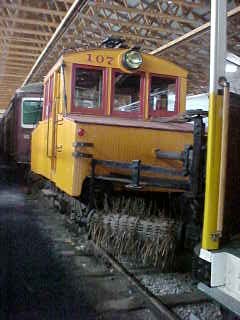
Scranton Transit Sweeper single-truck snow sweeper 107, a one-of-a-kind vehicle built by Chicago and Joliet Electric Railway in 1910 and is a four-wheeled car with rotating brooms at both ends. It is a "steeple cab" design with operator controls only in the middle. After the C&JER stopped operations in 1933, it went to Scranton until they stopped operating trolleys on December 18, 1954. Scranton snowsweeper 107 and passenger car 505 were taken to the Rail City museum in Sandy Pond, New York and ultimately to the Magee Transportation Museum in Bloomsburg, Pennsylvania. In 1972, Hurricane Agnes flooded the Magee museum, forcing its closing. Our Museum acquired 107 (and 505) in 1973. Sweeper 107 has been returned to operation at our museum and has been used many times to clear snow from the museum tracks.
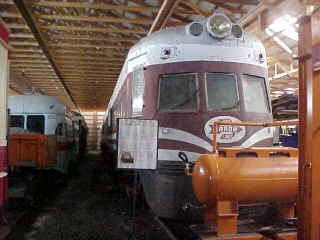
Liberty Liner 4-section articulated "Independence Hall" built by St. Louis Car Company in 1941. It is actually a four-car, air-conditioned interurban train which is permanently coupled together. The length of the train is 156 feet and was designed to be able to operate on the famous Chicago "L" picking up and discharging passengers. Both trains were designed for the North Shore line in an attempt to win back ridership from the competing Chicago Milwaukee, St. Paul and Pacific Railroad, as well as the personal automobile. At the time of their construction, the trains were the most modern interurban trains ever constructed.
The trains are unique in that they each had a tavern lounge car, famous for their "Electroburgers". Known as "Electroliners" on the North Shore, both trains operated between Chicago and Milwaukee, running for millions of miles over the years. The trains could easily operate at 90 MPH and had eight electric traction motors of 125 horsepower each giving the train 1,000 horsepower. The North Shore line abandoned operations on January 21, 1963 and both trains were sold to the Philadelphia Suburban Transportation Company, known as the Red Arrow Lines, of Upper Darby in suburban Philadelphia. They were moved on their own wheels from Chicago to suburban Philadelphia.
Once on the Norristown line, both trains were refurbished inside and out and were renamed Liberty Liners, one being named "Independence Hall" and the other "Valley Forge". The tavern lounge car served the passengers various breakfast, snack and light meal items in the mornings and afternoons. They even carried a liquor license, which was quite unusual for an interurban rapid transit operation. Both trains operated on the Norristown line into the 1970's.
The Liners were not well-suited for the type of operation on this 14-mile line which is full of curves, hills and short distances between stations. Rather they were designed for flat, mid-western terrain to operate at long distances between station stops. Both trains were put up for sale by SEPTA in 1981. Our museum was the successful bidder for the "Independence Hall". Six tractor trailers and a large crane were needed to dismantle the train, move it from Philadelphia and reassemble it at the museum. Since its arrival, our priorities have been to perform preventive maintenance, getting the train to operate and moving the train indoors for the first time in over 35 years.
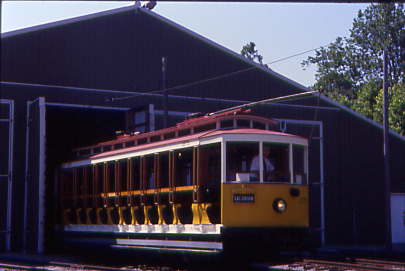
Our operator had excused himself to bring out Companhia de Transportes Coletivos open car 1875 built by Brill in 1912. Open cars were very expensive for the transit companies to operate. Unless the climate was always warm, the transit company needed to have a second set of cars for the passengers to ride during the winter weather. Rainstorms were also a problem, although curtains that could be drawn provided some relief. The public still loved the open cars in the hot summer months. It was necessary to have a crew of two people to operate an open car, a motorman to run the car and a conductor to collect the fares. This was a dangerous job for the conductor as he walked along the side running boards to collect the fares as traffic in the busy streets flew by him. For these reasons the open cars were replaced by closed cars or semi-convertible cars. It is the only open car operating in Pennsylvania.
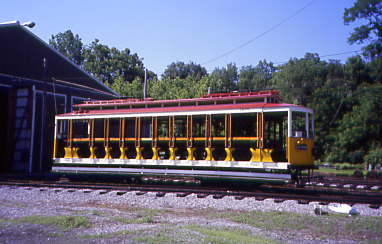
Car 1875 in the bright mid-July sunshine.
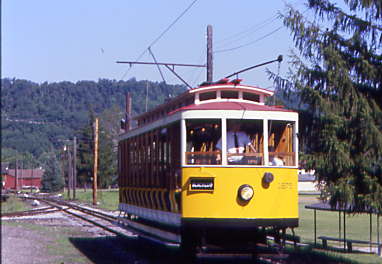
The car reversed out onto the mainline and came forward to pick us up for the safety run, to make sure the track and wire, and the car, are all working as they should.
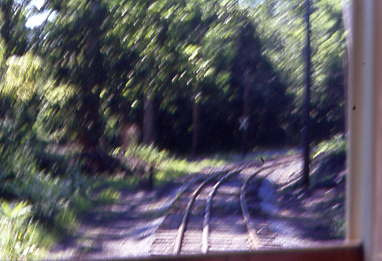
We proceeded up the line on the last part of the dual gauge track. The trolleys use the standard gauge tracks while the East Broad Top Railroad uses the narrow gauge tracks on the museum grounds to wye their trains.
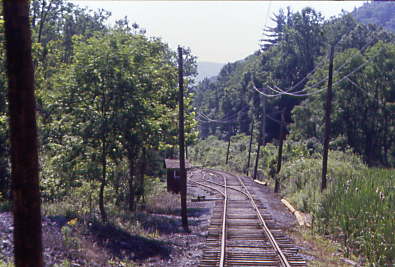
The trolley tracks follow Blacklog Creek on what used to be the Shade Gap Branch of the East Broad Top.
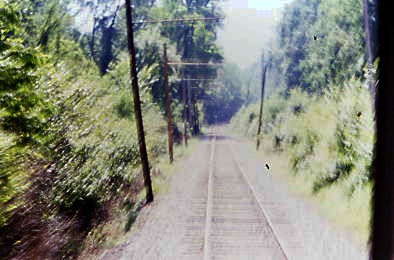
Further up the valley we travelled.

We neared the small two-track platform at the end of the line where we detrained for a few pictures.

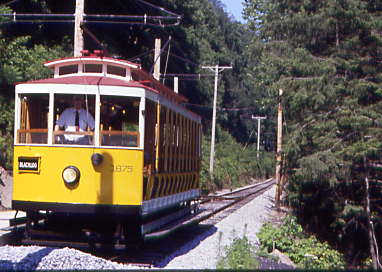
Car 1875 at the end of the line before returning to the museum.
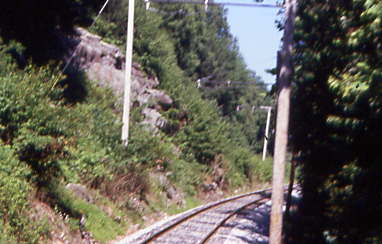
On the grade back to the museum.
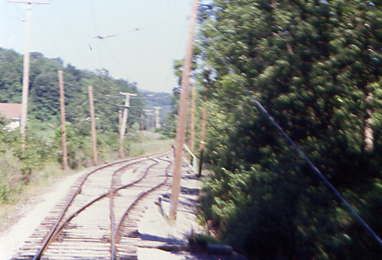
At the passing track.
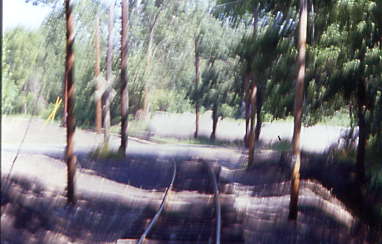
Curving in the forest.
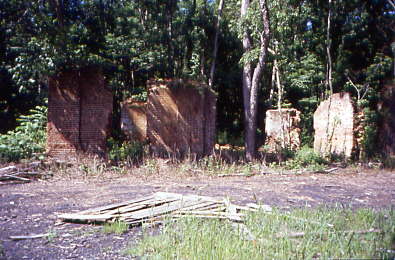
These are the remains of Rockhill Furnaces 1 and 2, casthouse and the Blast Engine House.


Running down the dual gauge to Car Barn 2.
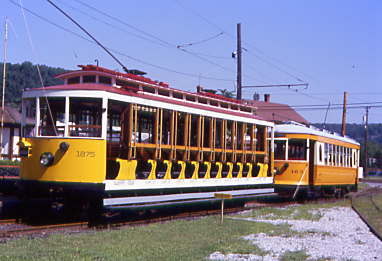
Our trip was over as we arrived back at the station platform, thanked our operator and walked over the East Broad Top tracks.
| RETURN TO THE MAIN PAGE |